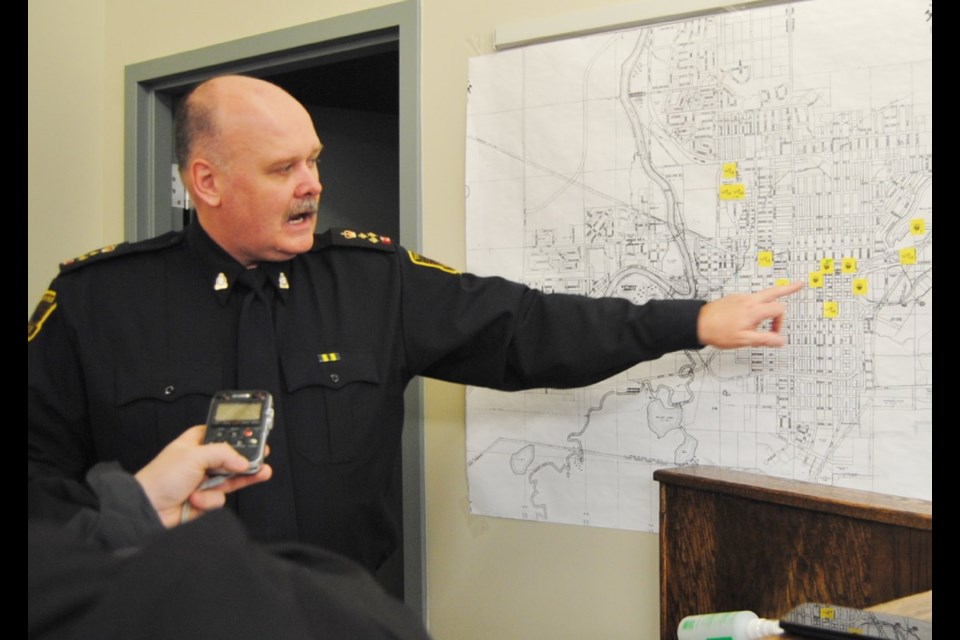Timmins Police Services board approved the movement of two closed circuit television (CCTV) cameras in order to monitor two high-accident intersections along Algonquin Blvd.
Police Chief John Gauthier recommended that the camera located at Algonquin Blvd E. and Cedar Street be moved to the corner of Algonquin Boulevard and Mount Joy Street.
The Algonquin-Mount Joy intersection has had several major accidents including a pedestrian fatality about 18 months ago.
The CCTV program in Timmins was initiated in 2013 and the city has 26 cameras in place.
A review of Timmins’ CCTV system was completed by Constable Tom Buczkowski. He is responsible for looking after the cameras and downloading footage if need for evidentiary purposes.
Chief Gauthier also recommended the movement of one of the three cameras situated at the Archie Dillon Sportsplex and relocating it to the intersection of Algonquin Boulevard West and Theriault Boulevard. That intersection also has had numerous accidents.
“The camera that was pointing to the soccer complex at the sportsplex and we would like to re-locate it to Theriault Boulevard - Algonquin Boulevard location because it has high volume of traffic and students from the high schools cross at that point,” explained Chief Gauthier.
Deputy Chief Des Walsh explained that footage on the CCTV cameras is used strictly as evidence in police investigations and subsequent court cases.
“They are not live monitored,” he informed the Police Services board. “They are used based on a request of an investigating officer resulting from an incident that already happened."
The cameras are not monitored live because Canadian privacy laws forbid police surveillance of the movements of Canadian citizens.
“The cameras are fixed-mounted and can only take general overall footage,” Gauthier explained. “They are not allowed to zoom in, tilt or pan in on a scene.”
“They are located in general locations and the picture we obtain is not focused in - it is drawn back quite a bit.,” Chief Gauthier added.
One example of the effectiveness of the CCTV in helping police to solve crime involved the theft of a skidder, a piece construction equipment, that was stolen in Timmins.
“We checked the cameras located on Algonquin and with the help of the OPP enhancement of the images to read the name on the truck that was used to haul the equipment away,” said Chief Gauthier.
“And were able to locate and apprehend the thief - we also recovered the skidder,” he added.
The CCTV has also played a role in investigating the movements of missing persons.
Steve Black, board chair and the mayor of Timmins, questioned the removal of the CCTV camera from the Algonquin Boulevard East and Cedar location. He cited the existence of well used large parking lot on the south side of Algonquin Boulevard as his reason for keeping the camera at the location.
“The intersection is also high volume because of people using the parking lot and there have been many accidents there as well,” Black said.
Councillor Michael Doody whose ward includes the Algonquin Boulevard and Cedar Street intersection praised the use of CCTV.
“It’s an example of how to prevent crimes in high risk areas,” he said. “We have apprehended suspects who were caught on CCTV many blocks away.
However, he too expressed concern about moving the camera away from the Algonquin-Cedar intersection.
“It has the second worst record for accidents,” Doody said.
Police Chief Gauthier agreed the CCTV cameras do serve as a crime prevention tool.
“We also have cams at the Whitney Skateboard Park and that’s why no mischief has taken place there,” Gauthier said.
Board member John Curley supports the moving of the cameras to deal with high rate of traffic accidents at the two locations in question – Mount Joy Street and Theriault Boulevard along Algonquin Boulevard.
“Unfortunately we can’t have them everywhere,” Curley said.
Curley wanted to know if the CCTV cams could also be used to capture red-light running through intersections which has led to many serious collisions along Algonquin Boulevard.
Mayor Black said they cannot be used for red-light infractions as the lens on the camera is not designed to capture the license plates sharply as the specially designed lenses on red light cameras are.
Black told the board that the city is making an application to the province for funding to install red light cameras at some intersections.



